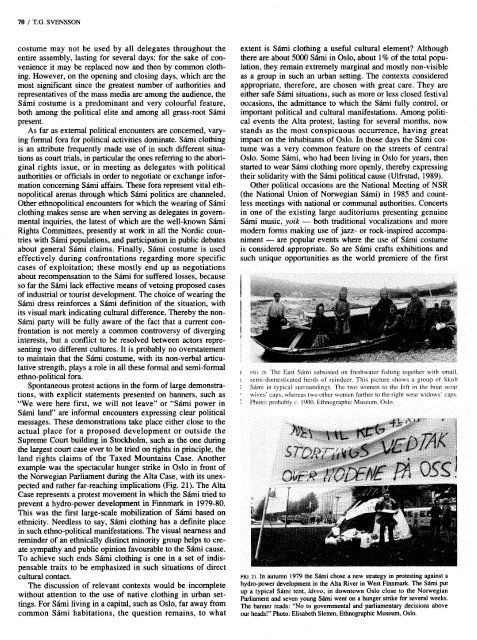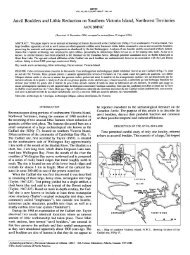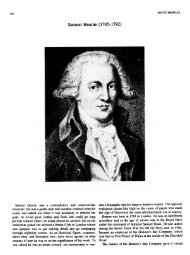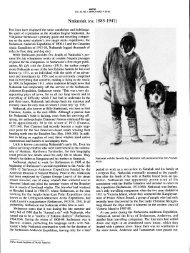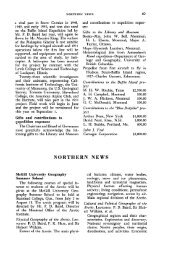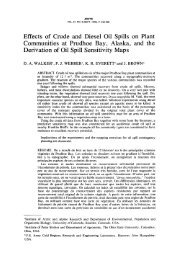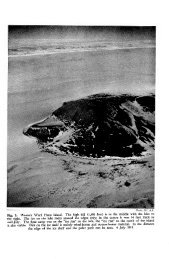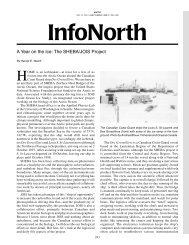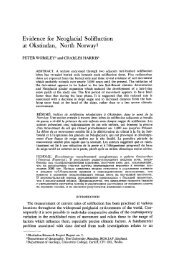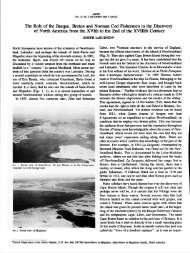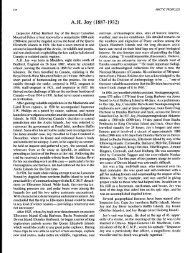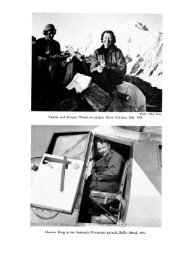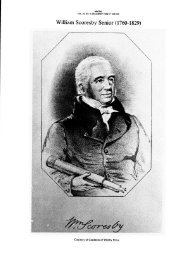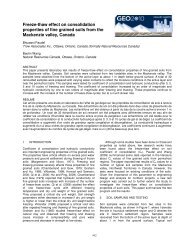Clothing in the Arctic - AINA Publications Server
Clothing in the Arctic - AINA Publications Server
Clothing in the Arctic - AINA Publications Server
Create successful ePaper yourself
Turn your PDF publications into a flip-book with our unique Google optimized e-Paper software.
70 I T.G. SVENSSON<br />
costume may not be used by all delegates throughout <strong>the</strong><br />
entire assembly, last<strong>in</strong>g for several days; for <strong>the</strong> sake of convenience<br />
it may be replaced now and <strong>the</strong>n by common cloth<strong>in</strong>g.<br />
However, on <strong>the</strong> open<strong>in</strong>g and clos<strong>in</strong>g days, which are <strong>the</strong><br />
most significant s<strong>in</strong>ce <strong>the</strong> greatest number of authorities and<br />
representatives of <strong>the</strong> mass media are among <strong>the</strong> audience, <strong>the</strong><br />
SBmi costume is a predom<strong>in</strong>ant and very colourful feature,<br />
both among <strong>the</strong> political elite and among all grass-root SBmi<br />
present.<br />
As far as external political encounters are concerned, vary<strong>in</strong>g<br />
formal fora for political activities dom<strong>in</strong>ate. Shi cloth<strong>in</strong>g<br />
is an attribute frequently made use of <strong>in</strong> such different situations<br />
as court trials, <strong>in</strong> particular <strong>the</strong> ones refemng to <strong>the</strong> aborig<strong>in</strong>al<br />
rights issue, or <strong>in</strong> meet<strong>in</strong>g as delegates with political<br />
authorities or officials <strong>in</strong> order to negotiate or exchange <strong>in</strong>formation<br />
concern<strong>in</strong>g Shi affairs. These fora represent vital ethnopolitical<br />
arenas through which Shi politics are channeled.<br />
O<strong>the</strong>r ethnopolitical encounters for which <strong>the</strong> wear<strong>in</strong>g of Shi cloth<strong>in</strong>g makes sense are when serv<strong>in</strong>g as delegates <strong>in</strong> governmental<br />
<strong>in</strong>quiries, <strong>the</strong> latest of which are <strong>the</strong> well-known Shi Rights Committees, presently at work <strong>in</strong> all <strong>the</strong> Nordic countries<br />
with Shi populations, and participation <strong>in</strong> public debates<br />
about general SBmi claims. F<strong>in</strong>ally, SBmi costume is used<br />
effectively dur<strong>in</strong>g confrontations regard<strong>in</strong>g more specific<br />
cases of exploitation; <strong>the</strong>se mostly end up as negotiations<br />
about recompensation to <strong>the</strong> Shi for suffered losses, because<br />
so far <strong>the</strong> Shi lack effective means of veto<strong>in</strong>g proposed cases<br />
of <strong>in</strong>dustrial or tourist development. The choice of wear<strong>in</strong>g <strong>the</strong><br />
Shi dress re<strong>in</strong>forces a Shi def<strong>in</strong>ition of <strong>the</strong> situation, with<br />
its visual mark <strong>in</strong>dicat<strong>in</strong>g cultural difference. Thereby <strong>the</strong> non-<br />
SBmi party will be fully aware of <strong>the</strong> fact that a current confrontation<br />
is not merely a common controversy of diverg<strong>in</strong>g<br />
<strong>in</strong>terests, but a conflict to be resolved between actors represent<strong>in</strong>g<br />
two different cultures. It is probably no overstatement<br />
to ma<strong>in</strong>ta<strong>in</strong> that <strong>the</strong> Shi costume, with its non-verbal articulative<br />
strength, plays a role <strong>in</strong> all <strong>the</strong>se formal and semi-formal<br />
ethno-political fora.<br />
Spontaneous protest actions <strong>in</strong> <strong>the</strong> form of large demonstrations,<br />
with explicit statements presented on banners, such as<br />
“We were here first, we will not leave” or “SBmi power <strong>in</strong><br />
SBmi land” are <strong>in</strong>formal encounters express<strong>in</strong>g clear political<br />
messages. These demonstrations take place ei<strong>the</strong>r close to <strong>the</strong><br />
actual place for a proposed development or outside <strong>the</strong><br />
Supreme Court build<strong>in</strong>g <strong>in</strong> Stockholm, such as <strong>the</strong> one dur<strong>in</strong>g<br />
<strong>the</strong> largest court case ever to be tried on rights <strong>in</strong> pr<strong>in</strong>ciple, <strong>the</strong><br />
land rights claims of <strong>the</strong> Taxed Mounta<strong>in</strong>s Case. Ano<strong>the</strong>r<br />
example was <strong>the</strong> spectacular hunger strike <strong>in</strong> Oslo <strong>in</strong> front of<br />
<strong>the</strong> Norwegian Parliament dur<strong>in</strong>g <strong>the</strong> Alta Case, with its unexpected<br />
and ra<strong>the</strong>r far-reach<strong>in</strong>g implications (Fig. 21). The Alta<br />
Case represents a protest movement <strong>in</strong> which <strong>the</strong> Shi tried to<br />
prevent a hydro-power development <strong>in</strong> F<strong>in</strong>nmark <strong>in</strong> 1979-80.<br />
This was <strong>the</strong> first large-scale mobilization of SBmi based on<br />
ethnicity. Needless to say, Shi cloth<strong>in</strong>g has a def<strong>in</strong>ite place<br />
<strong>in</strong> such ethno-political manifestations. The visual nearness and<br />
rem<strong>in</strong>der of an ethnically dist<strong>in</strong>ct m<strong>in</strong>ority group helps to create<br />
sympathy and public op<strong>in</strong>ion favourable to <strong>the</strong> Shi cause.<br />
To achieve such ends Shi cloth<strong>in</strong>g is one <strong>in</strong> a set of <strong>in</strong>dispensable<br />
traits to be emphasized <strong>in</strong> such situations of direct<br />
cultural contact.<br />
The discussion of relevant contexts would be <strong>in</strong>complete<br />
without attention to <strong>the</strong> use of native cloth<strong>in</strong>g <strong>in</strong> urban sett<strong>in</strong>gs.<br />
For Shi liv<strong>in</strong>g <strong>in</strong> a capital, such as Oslo, far away from<br />
common SBmi habitations, <strong>the</strong> question rema<strong>in</strong>s, to what<br />
extent is SBmi cloth<strong>in</strong>g a useful cultural elemenl :? Althc ough<br />
<strong>the</strong>re are about 5000 Shi <strong>in</strong> Oslo, about 1% of <strong>the</strong> total popu-<br />
lation, <strong>the</strong>y rema<strong>in</strong> extremely marg<strong>in</strong>al and mostly non-visible<br />
as a group <strong>in</strong> such an urban sett<strong>in</strong>g. The contexts considered<br />
appropriate, <strong>the</strong>refore, are chosen with great care. They are<br />
ei<strong>the</strong>r safe S hi situations, such as more or less closed festival<br />
occasions, <strong>the</strong> admittance to which <strong>the</strong> Shi fully control, or<br />
important political and cultural manifestations. Among politi-<br />
cal events <strong>the</strong> Alta protest, last<strong>in</strong>g for several months, now<br />
stands as <strong>the</strong> most conspicuous occurrence, hav<strong>in</strong>g great<br />
impact on <strong>the</strong> <strong>in</strong>habitants of Oslo. In those days <strong>the</strong> SBmi cos-<br />
tume was a very common feature on <strong>the</strong> streets of central<br />
Oslo. Some Shi, who had been liv<strong>in</strong>g <strong>in</strong> Oslo for years, <strong>the</strong>n<br />
started to wear S hi cloth<strong>in</strong>g more openly, <strong>the</strong>reby express<strong>in</strong>g<br />
<strong>the</strong>ir solidarity with <strong>the</strong> S hi political cause (Ulfrstad, 1989).<br />
O<strong>the</strong>r political occasions are <strong>the</strong> National Meet<strong>in</strong>g of NSR<br />
(<strong>the</strong> National Union of Norwegian Shi) <strong>in</strong> 1985 and count-<br />
less meet<strong>in</strong>gs with national or communal authorities. Concerts<br />
<strong>in</strong> one of <strong>the</strong> exist<strong>in</strong>g large auditoriums present<strong>in</strong>g genu<strong>in</strong>e<br />
SBmi music, yoik - both traditional vocalizations and more<br />
modem forms mak<strong>in</strong>g use of jazz- or rock-<strong>in</strong>spired accompa-<br />
niment - are popular events where <strong>the</strong> use of SBmi costume<br />
is considered appropriate. So are SBmi crafts exhibitions and<br />
such unique opportunities as <strong>the</strong> world premiere of <strong>the</strong> first<br />
I FIG. 20 The East Sami subsisted on freshwater fish<strong>in</strong>g toge<strong>the</strong>r with small,<br />
1 semi-domesticated herds of re<strong>in</strong>deer. This picture shows a group of Skolt<br />
I Sami <strong>in</strong> typical surround<strong>in</strong>gs. The two women to <strong>the</strong> left <strong>in</strong> <strong>the</strong> boat wear<br />
1 wives’ caps, whereas two o<strong>the</strong>r women far<strong>the</strong>r to <strong>the</strong> right wear widows’ caps.<br />
1 Photo: probably c. 1900, Ethnographic Museum, Oslo.<br />
FIG. 21. In autumn 1979 <strong>the</strong> Shi chose a new strategy <strong>in</strong> protest<strong>in</strong>g aga<strong>in</strong>st a<br />
hydro-power development <strong>in</strong> <strong>the</strong> Alta River <strong>in</strong> West F<strong>in</strong>nmark. The Shi put<br />
up a typical Simi tent, lbvvo, <strong>in</strong> downtown Oslo close to <strong>the</strong> Norwegian<br />
Parliament and seven young Shi went on a hunger strike for several weeks.<br />
The banner reads: “No to governmental and parliamentary decisions above<br />
our heads!” Photo: Elisabeth Sletten, Ethnographic Museum, Oslo.


